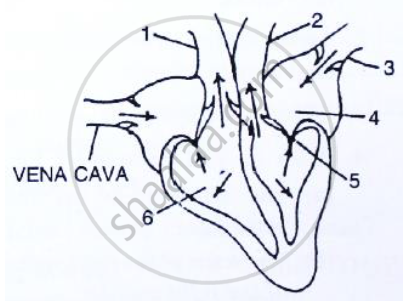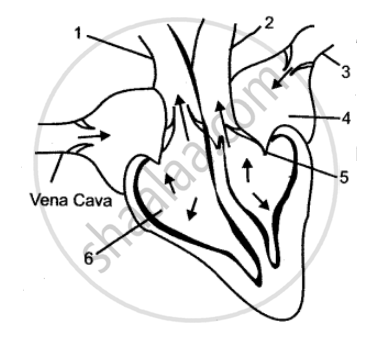Advertisements
Advertisements
प्रश्न
The diagram below depicts the human heart in one of its phases. Answer the questions that follow:

- Which part of the heart is in the contraction phase?
- Give a suitable reason to justify your answer in (a).
- Distinguish between Systole and Diastole.
उत्तर
- Ventricle parts of the heart.
- These are the lower two chambers of the heart.
- Distinguish between Systole and diastole:
| S. No. | Systole | Diastole |
| 1. | Occurs when the heart contracts to pump blood out. | occurs when the heart relaxes after a contraction. |
| 2. | The normal range of systolic blood pressure should be 90 - 120mmHg. | The normal range of diastolic blood pressure should be 60 - 80 mm Hg. |
APPEARS IN
संबंधित प्रश्न
The diagram given alongside represents the human heart in one phase of its activity. Study the same and then answer the question that follow:

Name the phase.
Name the following:
The first heart sound.
The diagram given below represents the human heart in one phase of its activity. Study the same and then answer the question that follow:
Name the parts numbered 1 to 6.

Explain the Term
Electrocardiogram (ECG)
State the Function: Semilunar valves of the heart
Draw labelled diagram of internal structure of human heart.
Label right atrium, mitral valve, left ventricle and pulmonary semilunar valve.
Write a function of Eustachian and tricuspid valve found in human heart.
Name two-layered protective covering of the human heart.
Identify the INCORRECT statement regarding heart.
The inner surface of the ventricle is thrown into series of irregular muscular ridges called ______
Fill in the blanks of the following paragraph using just two words – arteries and veins.
___(a)___ carry oxygen-rich blood from the heart to all parts of the body and ___ (b)___ carry carbon dioxide-rich blood from all parts of the body back to the heart. ___ (c)___ have thin walls and __ (d)___ have thick elastic walls. Blood flows at high pressure in ___ (e)____. Valves are present in __ (f) ___ which allow blood to flow only towards the heart. __ (g)___ divide into smaller vessels. These vessels further divide into extremely thin tubes called capillaries. The capillaries join up to form ____ (h)_____.
